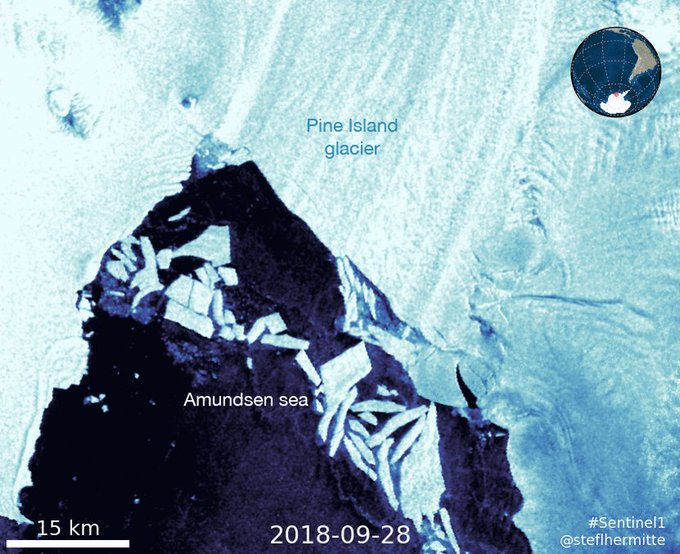Huge
Antarctic iceberg breaks off Pine Island Glacier

The
calving front of the Pine Island Glacier, seen by a NASA aircraft in
2016. Image: NASA IceBridge.
30
October, 2018
An
iceberg about five times the size of Manhattan has broken off the
Pine Island Glacier in West Antarctica over the past 24 hours, an
ominous sign of the continued retreat of this fast-flowing mass of
ice. Like many other marine terminating glaciers in Antarctica, this
glacier is retreating over time, and increasing the movement of ice
into the sea.
Why
it matters: While this iceberg itself is not record-breaking — it
ranks as the sixth-largest iceberg to break off the Pine Island
Glacier since 2001 — it illustrates the continued instability of
marine-terminating glaciers in parts of the icebound continent.
The
details: The iceberg had first appeared as a rift across Pine Island
Glacier in September, before leading to the calving of about 300
square kilometers, or 116 square miles, of ice. The largest
individual iceberg measures about 226 square kilometers in area, or
87 square miles.
#sentinel1 shows the rapid evolution from a rift across Pine Island Glacier in September to the calving of ~300km² of icebergs end of October, where the largest iceberg (226km²) will be named B-46 by NIC @CopernicusEU 1/2
In early 2000 large PIG calving events happened every ~5 yrs (2001, 2007, 2011), but since 2013 there were 4 of them (2013, 2015, 2017, 2018). Consequently, the glacier front retreated strongly from the 1972-2013 range and it is now ~5km further inland than in 2015-2017 2/2 pic.twitter.com/8O7gPyQAmh
Stef
Lhermitte, a geoscientist at the Netherlands' Delft University of
Technology who closely tracks Antarctic ice, tweeted that the glacier
front, where the ice meets the sea, has now receded by about 5
kilometers, or close to a mile inland compared to recent decades.
Ice
shelves, such as the one at the Pine Island Glacier, act like door
stops to the land-based ice behind it. Once they diminish, due to a
combination of warming from the ocean below and air temperatures
above, it's more likely that inland ice will collapse into the sea,
raising global sea levels.
Determining
the amount of future ice loss from Antarctica is the biggest source
of uncertainty in sea level rise projections, but recent studies have
suggested that Antarctic ice melt is likely to be at the higher end
of the scale.
- Recent research published in Nature Climate Change, found that "ice losses from Antarctica have accelerated during the past 25 years," and that 40% of the continent's sea level rise contribution has occurred during just the past 5 years.
- Antarctica lost
1,883 billion tons of ice between 2007 and 2017, which was
significantly higher than scientists estimated in a seminal report
published in 2013.
The
bottom line: The new iceberg is significant for reflecting trends
taking place around Antarctica, which many climate scientists find
worrisome.






No comments:
Post a Comment
Note: only a member of this blog may post a comment.